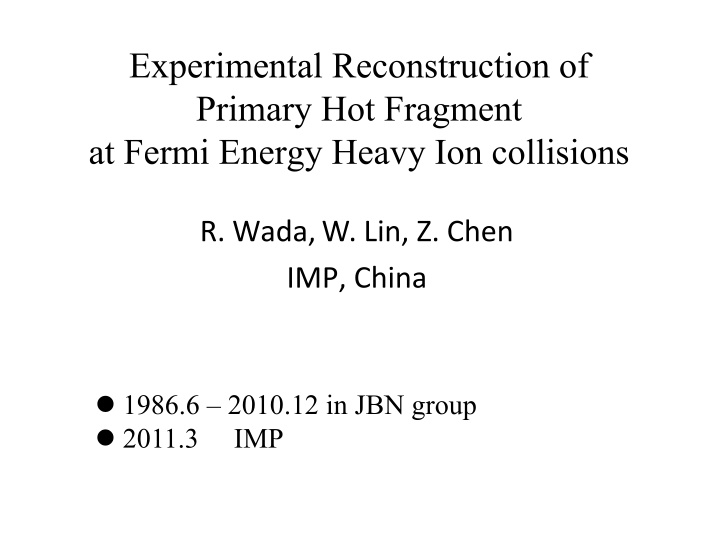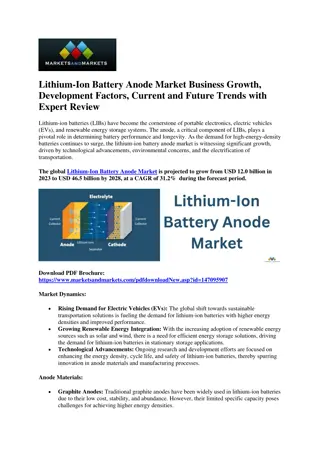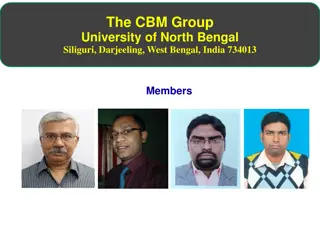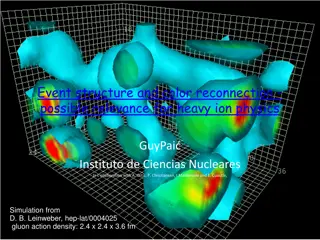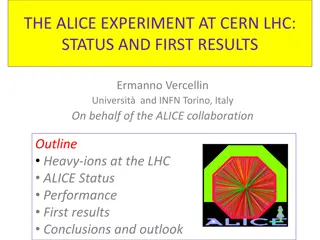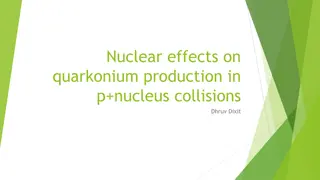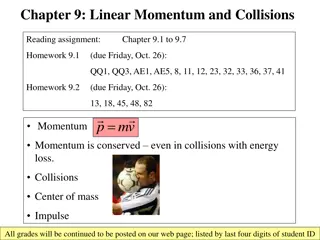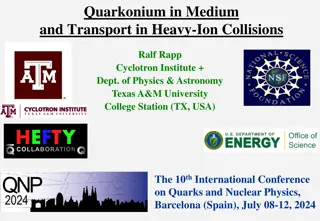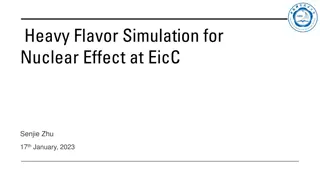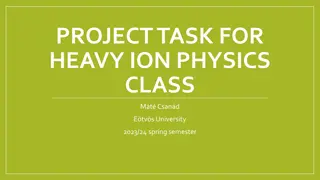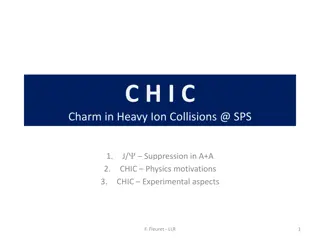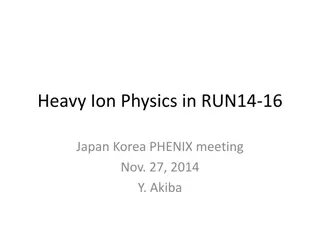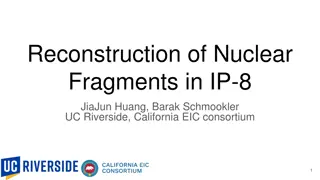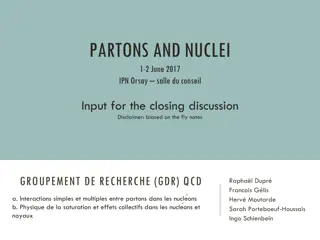Experimental Reconstruction of Primary Hot Fragment in Heavy Ion Collisions
"Investigation into primary hot fragment reconstruction at Fermi energy heavy ion collisions, utilizing experimental data and simulations to reconstruct excitation energy, mass, and charge of primary fragments. Techniques like kinematical focusing and isotope identification were employed, with a focus on neutron detection and multiplicity distributions. The study sheds light on the behavior of intermediate heavy ion reactions and provides insights into the dynamics of central collisions and reaction times."
Download Presentation

Please find below an Image/Link to download the presentation.
The content on the website is provided AS IS for your information and personal use only. It may not be sold, licensed, or shared on other websites without obtaining consent from the author.If you encounter any issues during the download, it is possible that the publisher has removed the file from their server.
You are allowed to download the files provided on this website for personal or commercial use, subject to the condition that they are used lawfully. All files are the property of their respective owners.
The content on the website is provided AS IS for your information and personal use only. It may not be sold, licensed, or shared on other websites without obtaining consent from the author.
E N D
Presentation Transcript
Experimental Reconstruction of Primary Hot Fragment at Fermi Energy Heavy Ion collisions R. Wada, W. Lin, Z. Chen IMP, China 1986.6 2010.12 in JBN group 2011.3 IMP
Intermediate Heavy Ion Reaction Central collisions Primary Secondary Experiments Reaction time
Kinematical focusing n IMF IMF Detector Uncorrelated LP Correlated LP v
Isotope Identification Black Histogram: Exp. Red: individual isotope Green : linear BG Blue: total IMF @ 20o 64Zn+112Sn at 40 A MeV @ 20o @ 20o
Neutrons with 23Na data 25o 35o IMF-n=15o 45o Total Uncorr(kMn(Li)) Corr(Mn(23Na)) 3.5 VIMF<4.5 cm/ns 4.5 VIMF<5.5 cm/ns 5.5 VIMF<6.5 cm/ns
Extracted Multiplicities Neutrons
A. Excitation energy of the primary fragments is reconstructed by (i =n,p,d,t, ) 1. < Ei> = 2T, (surface type Maxwellian) 2. Miis generated by a Monte Carlo method, using the multiplicity distribution from GEMINI simulation. 3. E (energy carried away by gamma emissions) is evaluated by GEMINI simulation.
Reconstructed Ex (Exp.) and Ex of primary fragments (AMD,SMM) Exp S A-1/3 Be A-1/3
A. Excitation energy of the primary fragments is reconstructed by (i =n,p,d,t, ) 1. < Ei> = 2T, 2. Miis generated by Monte Carlo method, using the multiplicity distribution from GEMINI simulation. 3. E (energy carried away by gamma emission) is evaluated by GEMINI simulation. B. Mass and charge of the primary fragments is reconstructed by Ahot= Ai Mi + Acold (i =n,p,d,t, ) ZiMi + Zcold Zhot=
Reconstructed multiplicity distribution 64Zn + 112Sn @ 40A MeV Exp. Reconstructed AMD primary
Z=10 64Zn+112Sn 64Ni+124Sn 0 Predicted associated neutron multiplicity
Neutrons with 23Na (5.5 <vIMF<6.5 ) 64Zn+112Sn 15o 25o 35o 45o 64Ni+124Sn -1 -2
64Zn+112Sn 64Ni+124Sn Neutrons Neutrons
Reconstructed Ex (Exp.) and Ex of AMD primary fragments 64Zn+112Sn Exp Ex (A MeV)
Coalescence technique : d2(I,j) = (ri-rj)2+ ((1/2 )2/ )(pi-pj)2< Rc2 = 0.16 fm-2 Z=10 Z=10 0 0Exp. AMD 20 0 0 15 0 00 0 00 0 0 0 0 00 10 0 0 00 0 5 20 30 A 0
64Zn+112Sn Exp Ex (A MeV) C.W.Ma et al., CPL Vol. 29, No. 6 (2012) 062101
Summary 1. Excitation energy and multiplicity of the primary hot fragments are reconstructed using a kinematical focusing technique. 2. Reconstructed Multiplicity distributions are well reproduced by the AMD primary isotope distributions. 3. Reconstructed excitation energies are not well reproduced by the AMD primary nor SMM prediction. Reconstructed excitation energy show a significant decrease as a function of isotope mass A for a given Z. 4. Coalescence method may need to take into account the effect of neutron (or proton) separation energy for neutron rich ( or proton rich) isotopes. 5. Very neutron rich isotopes may provide a good probe to study the hot nuclear matter in a point of least sequential decay disturbance.
M. Rodorigus (Instituto de Fisica, Universidade de S o Paulo) J. B. Natowitz (TAMU) K. Hagel (TAMU) A. Bonasera (TAMU) M. Barbui (TAMU) C. Bottosso (TAMU) K. J. Schmidt (Silesia Univ. Poland) S. Kowalski (Silesia Univ. Poland) Th. Keutgen (Univ. Cathoric de Louvain, W. Lin (IMP) R. Wada (IMP) M. Huang (IMP) Z. Chen (IMP) X. Liu (IMP) Belgium) Thank you for your attention
History to work with Joe 1986.3 Join JBN group 2010.12 ANL : CN decay SARA- AMPHORA : Multifragmentation, Caloric curve TAMU K-500 : Reaction dynamics, Caloric Curve, Symmetry energy BRAHMS : RHIC physics publications in major journals : 65 + 20 (BRAHMS) 2011.3 - present IMP, LANZHOU
Kinematical focusing n IMF Detector LP Detectors n IMF
Kinematical focusing Correlated LP Correlated LP Uncorrelated LP v
Target : 58,64Ni, 112,124Sn, 197Au, 232Th Experiment Projectiles: 64Zn,64Ni,70Zn at 40 A MeV 200 129-300-1000-1000 m 64Zn 47 A MeV 64Zn+112Sn at 40 A MeV IMF 20o
N.Marie et al., PRC 58, 256, 1998 S.Hudan et al., PRC 67, 064613, 2003 p Gemini d t 32 A MeV h 39 A MeV 45 A MeV 50 A MeV Exp
data Total Uncorr(kMn(Li)) Corr(Mn(23Na)) 3.5 VIMF<4.5 cm/ns 15o 25o 35o IMF-n 45o 4.5 VIMF<5.5 cm/ns 5.5 VIMF<6.5 cm/ns
64Zn+112Sn :64Ni+124Sn 64Zn+112Sn Exp. 64Ni+124Sm 64Zn+112Sm 64Ni+124Sn
Isotope distribution at 300fm/c 34Mg 17C He Ar Be Si S Li Mg C Ne B O Note: All isotopes are generated in very neutron rich side
(n- p)/T and Coulomb parameters R(I+2,I,A) = exp{ [2ac (Z-1)/A1/3 asym 4(I+1)/A (N+1,Z-1) + (N,Z)]/T } exp[( n- p)/T] I = 1 : even-odd: R(1,-1,A) = exp{ 2ac (Z-1)/A1/3/T } exp[( n- p)/T] ln[R(1,-1,A)] = 2ac (Z-1)/A1/3/T + ( n- p)/T ( n- p)/T ac/T Exp. 0.71 0.35 AMD Primary 0.40 0.18 Reconstructed (0.40 ) 0.12
asym= c(V )sym(1 c(S)sym/c(V )symA1/3): = c(V )sym(1 S/V /A1/3) c(V )sym c(V )sym S/V AMD primary 7.9 0.9 8.0 2.1 1.01 (T=5) 39.5 MeV 40 MeV Reconstructed 4.4 2.0 2.4 4.9 3.5 2.0 (T=5) 16.5 MeV ------------------------------------------------------ g.s. BE 32 2.0 72.3 1.2 2.26 (H. Jiang et al. PRC85,024301 (2012) )
Summary 1. Excitation energy and multiplicity of the primary hot fragments are reconstructed using a kinematical focusing technique. 2. Reconstructed Multiplicity distributions are well reproduced by the AMD primary isotope distributions. 3. Reconstructed excitation energies are not well reproduced by the AMD primary nor SMM prediction. Reconstructed excitation energy show a significant decrease as a function of isotope mass A for a given Z. 4. Coalescence method may need to take into account the effect of neutron (or proton) separation energy for neutron rich ( or proton rich) isotopes. 5. Very neutron rich isotopes may be in a very low excitation energy when they are formed and less disturbed by the sequential decay effect. This suggests that neutron rich isotopes provide a good probe to study the hot nuclear matter in a point of least sequential decay disturbance.
